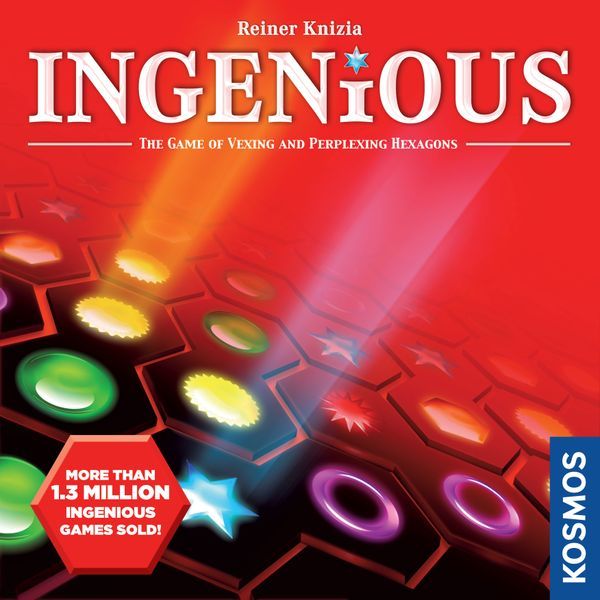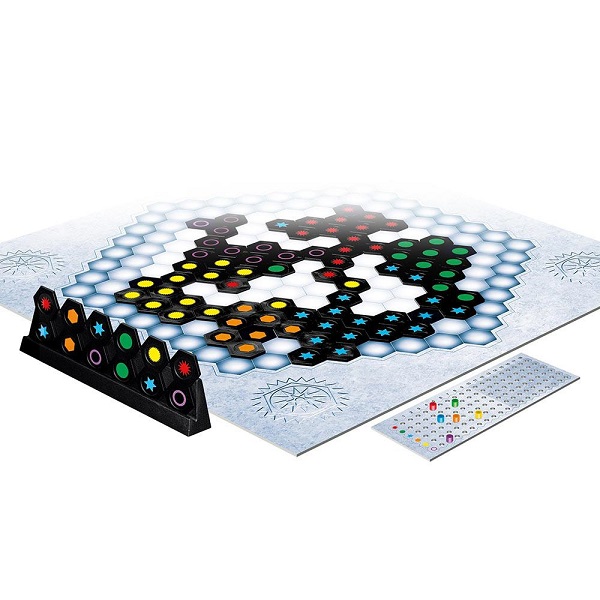No Color Left Behind in Tile Laying Game Ingenious

A 2004 Spiel des Jahres nominee and 2005 Mensa Select Winner, Ingenious is strategic and clever, while still being easy to learn.
Designed by Reiner Knizia (Lost Cities, The Quest for El Dorado) and published by KOSMOS, Ingenious may be over a decade old, but it still feels fresh and engaging.
Gameplay
The game features a large board of many connected hexagonal spaces. Each tile in the game fits on top of two of these spaces, featuring a colored symbol on each half of the tile. In total, there are six different colors in the game, and each player has a score board which tracks their points in each color. Additionally, each player has a hand of six tiles which they keep hidden from one another.
On your turn, you play one of your tiles onto the board, placing it on top of two empty spaces. You then score each half of the tile separately. When scoring a half of a tile, you look at the color on it and then look at each straight line of spaces on the board that lead out from it, counting each matching color in those lines. You stop counting on a line once you reach an empty space or another color. The total number you counted is how many points you earn from that half of tile. You never count either symbol on the tile you just played. You then add the points on your score board for the color you just scored. No color may ever score more than eighteen points. If a color ever reaches eighteen on your score board, you call out ‘ingenious’ and get to place an additional tile.
At the end of your turn, you draw a new tile. Once per turn, if none of the tiles in your hand shows the color of your lowest scoring color, then you may discard all your tiles and draw back up to six.
If any player ever manages to score eighteen on all colors, he instantly wins the game. More commonly, the game ends once no more tiles can be placed on the board. Your final score equals your lowest scoring color on your score board. If there is a tie, the tying players compare their second lowest color, and so on.

Review
Ingenious’s scoring system is the true heart of the game. The need to ensure that you have a decent number of points in all colors keeps the game tense and exciting. You’re also always keeping an eye on other players’ points as well, to see how much room you have to maneuver in the points department. It’s also one of the few games in which you tend to consider the tie-breaker as well.
Even though you do want to move all your colors forward, pushing far ahead with one to earn that bonus tile can also be helpful, and since each tile has two symbols, you can also pull off some really fun, big moves, and it feels quite satisfying when you do.
Being able to turn in all your tiles if you do not have a color that matches your lowest scoring color also helps to mitigate the luck factor of the game. Yes, you might have some bad luck in your tile draw, but you can do that full discard if you have to.
The score boards feature colored pegs to track your points. These are quite easy to read, which is important not only for your own decisions but also for deciding how best to block an opponent. The pegs, however, fit just tight enough to make it annoying to constantly be moving them and to raise concerns over how well the boards will hold up over extended usage.
Fans of abstract games should definitely check this one out. Ingenious is clever, easy to pick up, and gives you plenty to think about. There’s plenty of room to pull off some smart plays, while keeping the game at a nice pace.
Pros: Clever scoring system, nice speed to the gameplay, possible to mitigate bad luck
Cons: Some minor issues with the score boards
Disclosure: we received a complimentary review copy of this game.







